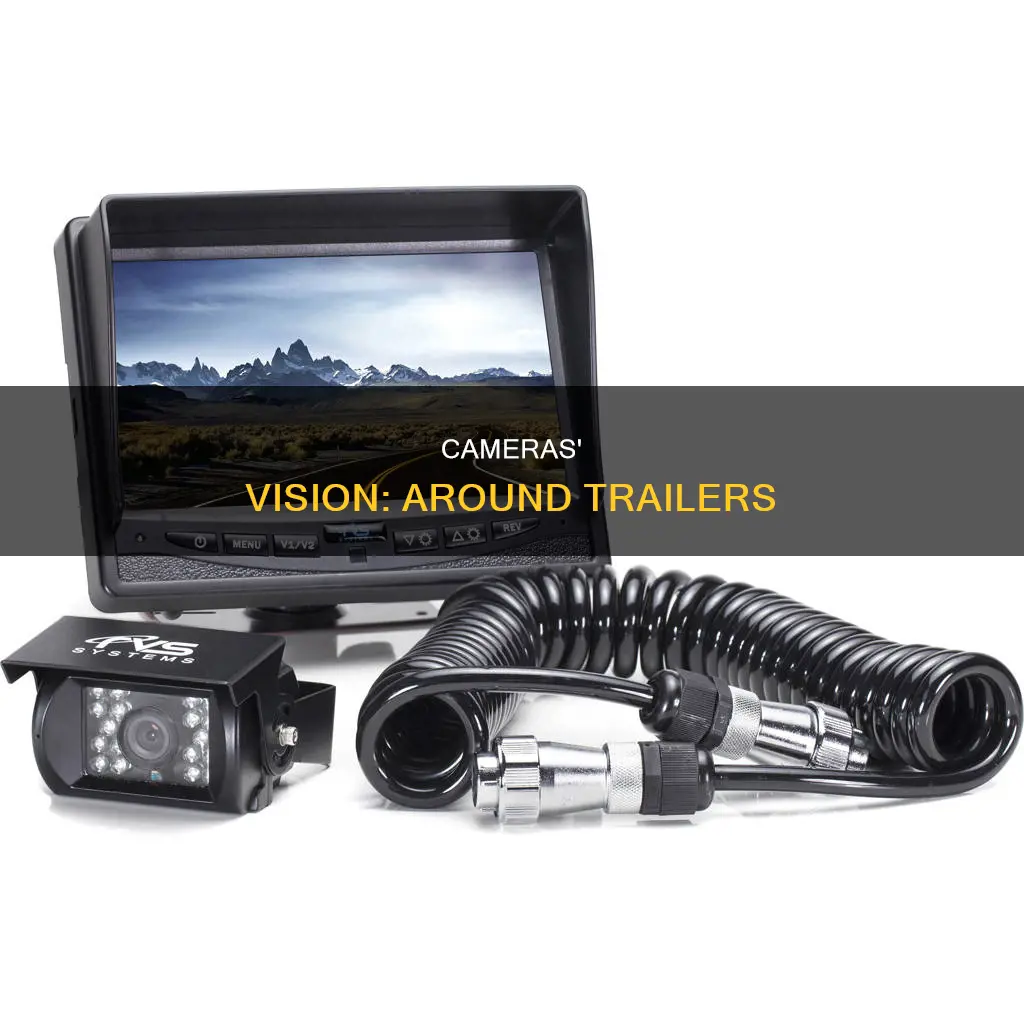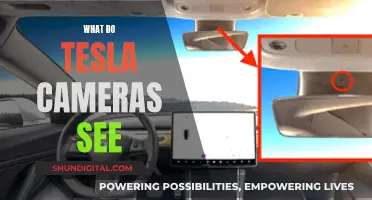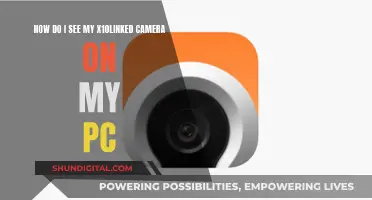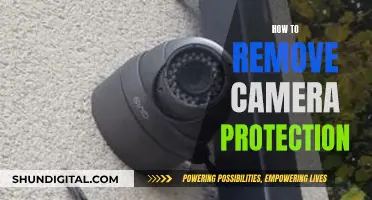
The latest truck technology includes backup cameras that can see-through trailers. This feature improves safety by helping drivers navigate challenging conditions such as reversing, parking, or changing lanes. The see-through effect is achieved by combining the outputs of cameras mounted on the truck and trailer, allowing drivers to see traffic and obstacles behind the trailer as if it were invisible. This technology enhances overall driving safety and reduces the risk of accidents, especially when towing large trailers or maneuvering in tight spaces.
| Characteristics | Values |
|---|---|
| Purpose | Enhance visibility and safety while towing large vehicles |
| Function | Utilises cameras and software algorithms to provide a clear view of surroundings |
| Camera Placement | Mounted on the vehicle and trailer to capture live video footage of the surrounding environment |
| Display | Monitor or touchscreen interface inside the vehicle |
| Camera Views | 15 different camera angles, including a transparent trailer view |
| Camera Switching | Manual or automatic when the system detects a potential obstacle |
| Camera Angles | Front, rear, hitch, bed, wide-angle rear surround, bowl, inside the trailer, and transparent |
| Image Processing | Combines and processes images to create a composite view of the vehicle and trailer's surroundings |
| Vehicle Integration | Integrated into select Chevy and GMC vehicles, including trucks and SUVs |
| Benefits | Improves visibility, reduces blind spots, enhances situational awareness, and helps with manoeuvring |
| Limitations | Environmental factors (e.g., weather conditions) and technical glitches may affect performance |
What You'll Learn

The camera system combines images from cameras on the truck and trailer
The system utilises multiple cameras strategically positioned on the truck and trailer to capture video footage from different angles. These cameras are typically mounted on the rear and sides of the truck, as well as the back of the trailer, to provide a 360-degree view and eliminate blind spots. The video streams from these cameras are then fed to a central processing unit, which combines and processes the images to create a composite view.
The resulting composite view is displayed on a monitor or touchscreen interface inside the vehicle's cabin, providing drivers with a clear and detailed representation of their surroundings. This setup allows drivers to see what's behind the trailer, which is traditionally obscured from view. It also enables them to monitor their cargo, check trailer tire pressure, and even control certain functions like air conditioning and water heater remotely.
The camera system's image processing capabilities enhance the video streams, creating a seamless and detailed view. Additionally, the software may incorporate features such as distance markers, trajectory lines, and warning alerts to assist drivers in making informed decisions and executing maneuvers with precision.
Overall, the combination of images from cameras on the truck and trailer provides drivers with improved visibility, situational awareness, and confidence while towing, ultimately enhancing safety for the driver, the trailer, and other road users.
Apple Watch Series 4: Camera-Equipped Timepiece?
You may want to see also

The trailer's edges are detected and outlined
The "see-through" trailer camera is an innovative safety feature designed to enhance visibility and improve safety for drivers of trucks and other vehicles towing trailers. This technology combines images from multiple cameras to provide a seamless and transparent view of the surroundings, including areas obscured by the trailer.
The process of creating this transparent view involves several advanced techniques. Firstly, cameras are strategically placed on both the vehicle and the trailer, capturing live footage from different angles. These cameras are typically mounted on the rear and sides of the vehicle, as well as the back of the trailer, ensuring comprehensive coverage of blind spots.
The images captured by these cameras are then processed and combined to create a composite view. This is achieved through advanced image processing techniques, such as image stitching and perspective correction, resulting in a seamless and detailed representation of the surroundings.
A crucial step in this process is the detection and outlining of the trailer's edges. The system identifies the edges of the trailer box and outlines them, allowing for a clear understanding of the trailer's dimensions and position. This outline serves as a reference point for creating the transparent effect.
The detection and outlining of the trailer's edges involve sophisticated algorithms and image processing capabilities. By identifying the trailer's edges, the system can distinguish the trailer from the surrounding environment. This information is then used to superimpose the trailer's outline onto the composite view, creating the illusion of transparency.
The outlined edges of the trailer provide a clear reference for the driver, enhancing their spatial awareness. This outline ensures that the driver can easily perceive the trailer's dimensions and position relative to other vehicles, road markings, or obstacles. As a result, the driver can make more informed decisions and execute manoeuvres with greater precision and confidence.
In summary, the detection and outlining of the trailer's edges are critical steps in creating the transparent trailer view. This technology enhances safety and improves the towing experience by providing drivers with a comprehensive understanding of their surroundings, reducing the risk of accidents and collisions.
Trail Cameras: Can Deer See Them?
You may want to see also

The driver can see vehicles directly behind the trailer
The "see-through" camera system combines images from a camera mounted on the back of the trailer and another camera on the back of the truck. It detects the edges of the trailer and outlines it, presenting a transparent image on a centre touchscreen or monitor. This technology improves the driver's visibility by effectively eliminating the blind spot caused by the trailer.
This feature is particularly useful when navigating through traffic, tight spaces, or crowded areas. It enables drivers to make informed decisions, execute manoeuvres with confidence, and reduce the risk of accidents or collisions. The system may also include visual aids such as distance markers, trajectory lines, and warning alerts to further assist drivers in towing and parking situations.
The "see-through" camera system is an innovative safety feature designed to enhance the driving experience and promote road safety. It empowers drivers with improved situational awareness, making it easier to navigate challenging conditions and reducing the likelihood of accidents or damage to the vehicle, trailer, or surrounding property.
Overall, the "see-through" camera system is a valuable tool for drivers, providing them with a clear view of their surroundings and helping them make precise and accurate manoeuvres with confidence.
Is Your TV Watching You?
You may want to see also

Cameras can be added inside the trailer
The camera system inside the trailer provides drivers with a comprehensive view of their surroundings, helping them make informed decisions and execute manoeuvres with confidence. This is particularly advantageous when navigating through tight spaces, crowded areas, or busy traffic.
The interior trailer camera can be part of a multi-camera system, such as the ProGrade Trailering Camera System offered by certain trucks, which offers a range of camera angles to improve visibility. This includes views of the hitch and bed, allowing drivers to monitor the cargo area, as well as a wide-angle rear surround view and a bowl angle, showing the truck from a few feet in front.
The trailer camera can be combined with a camera attached to the back of the trailer and the rear camera on the truck to create a "see-through" or transparent trailer view. This technology overlays the images from the cameras, detecting and outlining the edges of the trailer to create a completely transparent image. As a result, drivers can see any vehicles or obstacles directly behind the trailer, improving safety and reducing the risk of accidents.
Additionally, the interior trailer camera can provide real-time monitoring, allowing drivers to keep an eye on the trailer's contents and ensure that loose items are not causing any issues. This added visibility can provide peace of mind and help prevent potential hazards during transport. Overall, adding cameras inside the trailer can greatly enhance the driver's awareness and make towing large vehicles safer and more manageable.
Becoming a TV Camera Person: Skills and Steps
You may want to see also

The system switches camera angles manually or when it detects an obstacle
The ProGrade Trailering Camera System, offered by certain trucks, is a multi-camera system that improves the driver's visibility beyond what a standard blind-spot camera can offer. It has 15 different camera angles, which can be switched manually or automatically when the system detects a potential obstacle on the road.
The system includes three front camera angles and four rear camera angles for the truck itself. It also has camera angles for the hitch and bed, allowing drivers to monitor the cargo box. There is also a wide-angle rear surround angle and a bowl angle, which shows the truck from a few feet in front of the car.
One of the most notable features of this system is the transparent see-through camera view. This is achieved by lining up the images from the camera attached to the back of the trailer and the camera on the back of the truck. It then detects the edges of the trailer box and outlines it, presenting a completely transparent image of the trailer on the center touchscreen. This allows drivers to see any vehicles that are directly behind the trailer.
The camera system also includes views inside the trailer and the option to install and connect to a camera inside the trailer to monitor loose items. This level of visibility and control is a significant enhancement for drivers towing large trailers, boats, or RVs, as it eliminates blind spots and improves overall safety on the road.
Blender Camera Viewing: A Step-by-Step Guide
You may want to see also
Frequently asked questions
The "invisible" trailer towing camera works by using a camera on both the back of the truck and the back of the trailer. The vehicle then combines these two angles to create one seamless view.
The 2020 Chevrolet Silverado 1500, 2020 Silverado 2500 HD, 2019 GMC Sierra 1500, 2020 Sierra 2500, and 2020 Sierra 3500.
The primary purpose of the invisible trailer camera is to improve visibility and safety while towing by eliminating blind spots and providing drivers with a clear view of the road behind the trailer.







